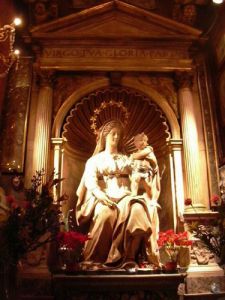Madonna del Parto
Madonna del Parto
Q: Tell us about Our Lady of Smooth Delivery?
A: In our modern world of high-tech hospitals, the age of difficult and dangerous childbirth seems a distant memory. While women rarely need to fear loss of life in childbirth, delivery is rarely pleasant and marks the beginning of many sacrifices involved in raising their children. In the beautiful Church of Sant'Agostino near the Piazza Navona, the Virgin Mary, patron of all mothers, was celebrated on Oct. 9 during the feast of the Madonna of Childbirth.
While there are many associations between this church and motherhood, this feast involves a famous statue housed in its own special niche at the back of the church. It has been venerated by thousands of Romans over the centuries as the Madonna of childbirth.
Carved in 1521 by Florentine sculptor Jacopo ("il Sansovino") Tatti, the statue is placed in a marble triumphal arch. The Blessed Mother holds her Son on her knee and both are gilded with gold accents. Sansovino created an image of a strong, voluminous Mary, a woman who to the Renaissance eye could withstand the arduous task of childbirth.
She also tolerates the pains of motherhood. She protectively holds her Son with one hand, but as the Child's front foot suggests, the time will soon come when Jesus will leave her to take up his mission.
For almost five hundred years, Roman women have prayed to Blessed Virgin before this statue asking for safe deliveries and healthy babies.

The Madonna del Parto rarely disappoints. Hundreds of silver ex-votos arrayed around the niche attest to her many interventions deemed miraculous by those who lives were saved. Silver hearts, plaques and baby announcements remind women that their courageous acceptance of motherhood holds a special place in the heart of the Madonna and Child.
Particularly moving are the modern offerings such as the pink and blue bows used to adorn a house where a baby has just been born. Photographs abound, with dozens of radiant faces of beaming mothers and babies tacked to the walls of the shrine.
The feast of the Madonna of childbirth lasts five days. The first three days consist of preparation, like Advent before Christmas or the months of gestation. Participants attend liturgies, rosaries and penance services while awaiting the big day. Saturday evening began the festivities with a Mass for expectant mothers. Archbishop Angelo Comastri of Loreto, site of the Holy House of Mary and Jesus, celebrated the Mass for the numerous radiant mothers-to-be in the church.
Sunday was an ongoing celebration of the family--Mass for wedding anniversaries, renewal of vows of consecration and blessings of small children followed one after another all day.
This lively, colorful happy Mass brought together the Catholic families of Rome--families that are menaced today not by unsafe medical conditions or infant mortality, but by the dwindling European birthrate and the legal redefinition of the very word "marriage." This joyous group of faithful entrusted itself to the protection of the Madonna of childbirth.
Even after the first tricky years of infancy when children were once prey to many illnesses, parents found that as their offspring got physically stronger, new, spiritual ills, emerged to beset them. The Church of Sant'Agostino also addresses the perils of youth with another great patron of mothers.
To the left of the main altar lies the burial chapel of St. Monica, mother of St. Augustine. As a mother whose prayer and tears negotiated a wayward teen-ager into a Father of the Church, she seems certainly a fit intercessor even for modern parents.
All About Mary includes a variety of content, much of which reflects the expertise, interpretations and opinions of the individual authors and not necessarily of the Marian Library or the University of Dayton. Please share feedback or suggestions with marianlibrary@udayton.edu.
